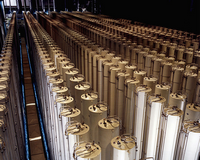The International Atomic Energy Agency (IAEA) recently completed its most comprehensive assessment in months of Iran's nuclear program and Tehran's degree of cooperation with the agency and U.N. Security Council resolutions. Although the Aug. 28 report (.pdf) notes some new developments, its basic message is that Iran has not appreciably changed its main nuclear policies despite years of negotiations, U.N. sanctions, and its recent presidential elections. As a result, as in the past, both advocates and opponents of harsher sanctions on Tehran can cite some of the agency's findings to support their positions.
The report, which was promptly leaked to the media, relates that Iran is still not providing the IAEA with the information required to determine the accuracy of intelligence indicating that Iranians earlier conducted studies regarding the military application of nuclear technologies. These include how to make a nuclear warhead and a re-entry vehicle capable of delivery on Iran's ballistic missiles. Iranian officials continue (.pdf) to either characterize some of the "alleged studies" as involving non-nuclear materials whose substance could not be revealed because they concerned Iran's national security, or else dismissed the evidence altogether as forgeries. They have repeatedly denied IAEA requests for access to essential documents, sites, and individuals that might clarify these activities.
The report also noted that the Iranian government continues to enrich uranium at the Natanz Fuel Enrichment Plant and construct a IR-40 heavy water nuclear research reactor at Arak despite several UNSC resolutions instructing Tehran to halt such activities. Although Iran continues to construct centrifuges at Natanz, IAEA inspectors found that fewer centrifuges were enriching uranium on this occasion: 4,600, as compared with the 4,900 that were operating at the time of the last IAEA report in June. The latest report does not explain why Iran has been feeding less uranium oxide ore into its centrifuges, whose overall number (active and inactive) has now grown to 8,300. The decrease could represent an overture to the international community or, more likely, result from either technical difficulties, a need to take the centrifuges temporarily offline for regular maintenance, or from the international sanctions that have sought to restrict Iran's ability to import nuclear materials. In any case, the thousands of functioning centrifuges have enabled Iran to increase its reported stockpile of low-enriched uranium hexafluoride (UF6) to 1,508 kilograms, up from 839 kilograms in June. If enriched further, this quantity could allow Iranian technicians to manufacture at least one and possibly two atomic bombs.

